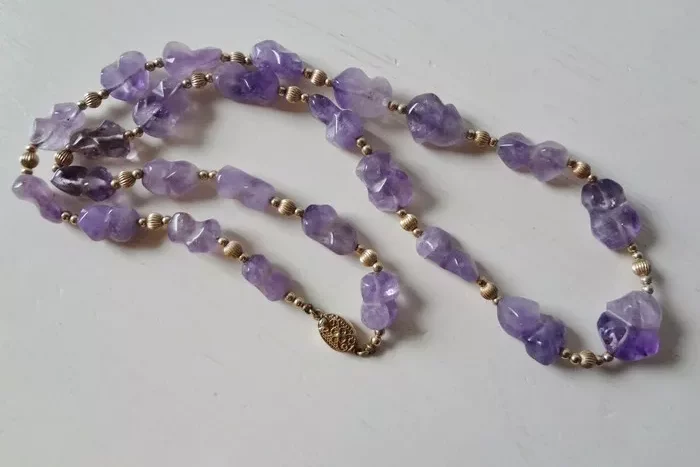Amethyst, a captivating variety of quartz renowned for its stunning purple hues, has garnered attention and admiration for millennia. Its enchanting coloration, which ranges from delicate lavender to deep, rich violet tones, is the result of trace elements and natural radiation within the gemstone. Among the myriad shades of amethyst, some colors are particularly rare and highly valued. Identifying the rarest amethyst colors requires a combination of knowledge, experience, and careful observation. This guide aims to provide a comprehensive understanding of how to identify the rarest amethyst colors, drawing on the expertise of jewelry appraisers and gemologists.
Understanding Amethyst Coloration
To identify the rarest amethyst colors, it is crucial to first understand the factors that influence amethyst’s coloration. Amethyst’s purple hues are primarily caused by the presence of iron and trace amounts of other elements within the quartz crystal. When quartz is exposed to natural radiation, such as that found in geologically active areas, the iron ions within the crystal undergo a process called charge transfer, which results in the absorption of certain wavelengths of light and the reflection of others. This absorption and reflection of light give amethyst its distinctive purple color.
The intensity and shade of amethyst’s purple hues can vary widely, depending on the concentration of iron and other trace elements, as well as the specific geological conditions under which the quartz formed. For example, amethyst with a higher iron content may appear darker and more reddish-purple, while amethyst with lower iron content may exhibit lighter, more lavender tones.
Identifying the Rarest Amethyst Colors
Identifying the rarest amethyst colors involves several steps, including visual inspection, gemological testing, and market analysis. Here’s a detailed breakdown of the process:
Visual Inspection
Hue and Saturation: The rarest amethyst colors are often those with the most vivid and intense hues. While there is no definitive “rarest” color, deep, rich purples with high saturation levels are generally more sought-after and valuable. Look for amethyst with a consistent, even color distribution and a strong, vibrant hue.
Clarity: Clarity is another important factor in identifying high-quality amethyst. The fewer inclusions and flaws within the gemstone, the more valuable it is likely to be. Look for amethyst with clean, transparent crystals that are free of cracks, scratches, and other imperfections.
Cut and Polish: The way an amethyst is cut and polished can also affect its appearance and value. A well-cut amethyst will maximize its color and clarity, creating a more striking and appealing gemstone. Look for amethyst with a good balance of proportions, smooth polished surfaces, and well-faceted edges.
Gemological Testing
Spectroscopy: Spectroscopy is a scientific method used to analyze the absorption and reflection of light by gemstones. By examining the absorption spectrum of an amethyst, gemologists can determine its iron content and other trace elements, which can help identify its color origin and rarity.
Refractometry: Refractometry involves measuring the refractive index of a gemstone, which is a measure of how much light is bent as it passes through the material. Amethyst has a specific refractive index range, and gemologists can use this information to confirm its identity and assess its quality.
Fluorescence Testing: Some amethyst gemstones exhibit fluorescence under ultraviolet light. While fluorescence is not necessarily indicative of rarity, it can provide additional information about the gemstone’s composition and origin.
Market Analysis
Demand and Supply: The rarity of an amethyst color is also influenced by market dynamics. Colors that are in high demand and low supply are more likely to be considered rare and valuable. Stay informed about current market trends and auction results to understand which colors are most sought-after.
Historical Context: The historical significance of certain amethyst colors can also affect their perceived rarity and value. For example, amethyst has been associated with royalty and spiritual significance throughout history, and these associations can influence its market perception.
Examples of Rare Amethyst Colors
While there is no definitive list of the rarest amethyst colors, several shades stand out as particularly unusual and valuable. Here are a few examples:
Siberian Amethyst: Siberian amethyst, sourced from Russia, is known for its deep, rich purple hues with a slight reddish cast. This color is highly sought-after for its intensity and saturation, making it one of the rarest and most valuable amethyst shades.
Uruguayan Amethyst: Uruguayan amethyst is renowned for its vibrant, vivid purple tones with a slight blue undertone. This color is particularly popular in the jewelry industry due to its striking appearance and consistent quality.
Brazilian Amethyst: Brazilian amethyst can exhibit a range of hues from light lavender to deep purple. However, the rarest and most valuable Brazilian amethyst is characterized by its intense, almost velvety purple color with a slight greenish cast.
Conclusion
Identifying the rarest amethyst colors is a complex process that requires a combination of knowledge, experience, and careful observation. By understanding the factors that influence amethyst coloration, conducting gemological testing, and staying informed about market trends, jewelry appraisers and gemologists can accurately assess the rarity and value of amethyst gemstones. Whether you’re a collector, investor, or jewelry enthusiast, understanding how to identify the rarest amethyst colors can help you appreciate and value these stunning gemstones even more.
Related topic:
- What Does the Moon Symbolism Mean in Amethyst Jewelry?
- What Should You Know Before Buying a Moon Amethyst Necklace?
- Gift Ideas: Amethyst Dragon Necklaces for Birthdays and More


